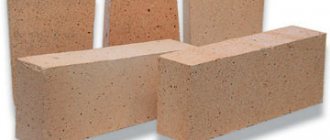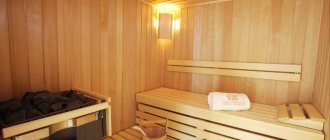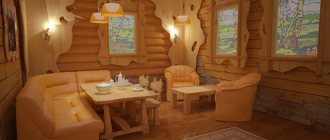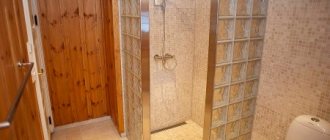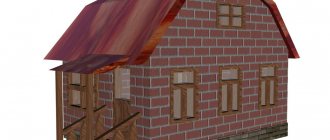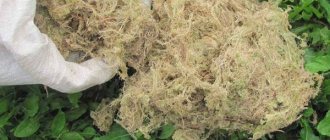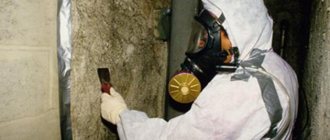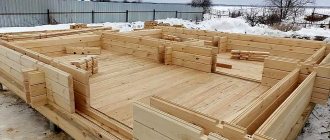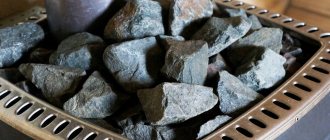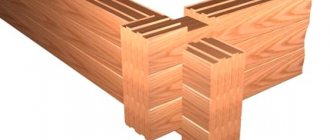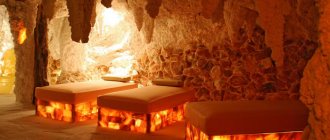The choice of lumber for construction and finishing is always accompanied by questions about which type of wood will provide better quality and longer service life.
It is necessary to compare characteristics and cost, since these are the parameters that are usually decisive.
Wooden products made from pine, spruce and larch are the most common in Russia, and they can be purchased from almost any company specialized in building materials.
Unfortunately, there is virtually no interest in some breeds that deserve closer attention, although the history of their use proves that they are in no way inferior to the more popular and in demand.
These include the undeservedly forgotten aspen, lumber and products from which are practically never found on the open market today, since production is carried out mainly to order.
This is explained by the limited demand for aspen wood due to the lack of awareness of buyers about its characteristics and possibilities of use.
Choosing what is best for a bath...
To understand what you are dealing with, it is correct to compare different options. We have already written about the popular dilemma of choosing between linden and aspen, now we will consider two other pairs that are compared a little less often.
Pine or aspen
Be prepared for the fact that there will be no clear answer. Because first of all you need to look at the quality of the same pine and the same aspen - there are regions where one is better than the other.
By the way! According to tradition, pine was usually used to build a house, and aspen was used for baths.
But it is always difficult to obtain good, functional aspen without rot inside ; there is a lot of defects at the selection stage. Here, by the way, is a big piece of advice for the owner of a future bathhouse - check each log yourself when purchasing - so that the core is intact, it suffers primarily from rot.
You need logs - 15-20 centimeters or more, so be careful - trees of this thickness most often have a problematic core.
ON A NOTE! Rotting aspen is accompanied by the smell of vanilla - if you smell it, put the log aside from healthy ones.
In this regard, pine is less susceptible to rot and pests, but it swells greatly from water. And resin is a problem in a steam room.
pure pine without interior decoration of a steam room , so there is no need to say which is better: a bathhouse made of aspen or pine - the choice lies between a pine bathhouse with aspen lining inside the steam room or an aspen bathhouse without lining trim.
If you prefer a log house in its pure form , if there is no need for additional insulation, then make it from aspen - everything will be fine, it will only become harder later, water “hardens” it.
If there are problems with a good aspen, if you know that a poplar in instead of it (they are relatives, the wood is very similar, but its quality is different, aspen grows in a swamp, hence its resistance to water, poplar does not have it), then take a good construction pine , build a log house from it, and protect yourself from resin with a clapboard made of aspen or linden (or other hardwood). See more information about pine here.
Alder or aspen
But here it’s more interesting - both are deciduous, both are suitable for finishing a paired room. As for a log house, aspen is definitely suitable for its construction, and alder is considered a good interior(!) material - its characteristics are similar to linden.
Therefore, we would risk recommending the following: focus here on the quality of the material. Since there is little good aspen, and specifically in your region there is good alder, you can build from it, but on condition that the lower crowns are made of oak or larch (contact with water and soil for alder leads to rotting).
BY THE WAY! The rule of the lower crowns, that is, making them from more durable and rot-resistant species, can be applied to aspen - only you will make it better.
In addition, the areas under the windows - this is a reason to take care of additional protection of these areas or to abandon windows as much as possible, leaving only the necessary ones.
In general, in the question of what is better for a bathhouse: alder or aspen, we place our bet on aspen, relying in this, as you already understand, on tradition.
Comparison of two tree species
Pine and aspen are used more often than other wood to create log bathhouses. This is due to their prevalence and relatively low price. Although it is impossible to call the construction of log houses cheap.
As building materials, pine and aspen have a number of differences:
- Pine is a coniferous tree , and aspen is a deciduous tree . Therefore, pine logs at high temperatures begin to release pine essential oils, which in large doses cause headaches and even suffocation. In addition, during the first five years the pine will actively resin, so visitors to the steam room can easily get burned by hot resin drops. As for aspen, there are no such problems with it.
- The building material of these rocks varies greatly in price . Aspen has a soft center that is often susceptible to disease and rot. A seemingly healthy tree can be destroyed from the inside. Most often, this phenomenon occurs in Russia, so most often aspen is ordered from abroad. But even so, defective aspen beams are more common than pine beams. Because of all this, aspen is much more expensive than pine.
- As a building material, pine is easier to process than aspen. In addition, the longer a tree lies, the harder it is to cut it down.
- Aspen is more durable than pine. Pine is more susceptible to the development of fungus and mold and is less moisture resistant. An aspen bathhouse will serve its owners for decades.
Service life of an aspen bath
Of course, no one can predict the service life of an aspen bathhouse specifically in your case. Wood is different everywhere, and aspen is capricious - it is advisable to cut it down in the spring, and select the trunks so that there is no rot even in the initial stage.
During operation , you can also extend or shorten the service life - it depends on whether you have provided all the conditions for drying or not.
From the outside, the structure is exposed to atmospheric precipitation, so it is advisable to treat the log house with antiseptics and water-repellent impregnations - this will also have a positive effect on its service life. We wrote about processing logs for log houses here, and about processing timber here.
And you shouldn’t believe those who say that antiseptics on the outside will affect the atmosphere inside - even industrial processing does not penetrate the log deeply, and independent impregnation goes no more than 3-5 mm . Therefore, it requires renewal every few years.
Inside, as already mentioned, there is thoughtful ventilation , plus, possibly, water-repellent, harmless impregnation with oil or oil wax. This is essential for the steam room and washing room; in other rooms you can varnish, paint – whatever you like.
Well, if you need at least some numbers, we found these on one of the forums: the builders themselves give the average log bathhouse made of aspen 20 years , but if the wood is selected well and the conditions are provided, then the bathhouse can last for half a century .
Where does rotten aspen come from?
Aspen has been affected by a fungus since childhood - it settles inside the trunk and gradually turns the wood into dust. It looks like a good tree, but if you cut it down, it’s rotten!
And suddenly, in 1948, first in the forests of Kostroma, then in Kalinin and some other regions, “islands” of unprecedented greenish aspens were discovered. Their trunks are smooth, clean, without a single knot, the bark is light green and smooth.
The aspens were much taller than the neighboring spruces and pines - they towered above them like a green tent. And most importantly, not a single one was affected by the fungus. No matter how many trunks were examined, all were healthy. At first they decided that it was some unknown species of aspen. But then we realized: this is exactly what aspen should be. And people are largely to blame for its troubles. For many years, they cut down healthy trees first, and left those affected by the fungus in the forest. These trees produced offspring susceptible to the disease. So, in the end, it turned out that the forests were inhabited mainly by aspen trees affected by the fungus. That’s why they gave up on aspen: what can you expect from this tree, it’s rotten anyway!
Where can I get a good tree?
There was only one thing left: to correct the mistake, to return the aspen to its former health. Scientists have taken as allies the few surviving aspen trees that are not afraid of the fungus invasion and have found a way to quickly propagate this variety. It was then that the aspen showed itself: it became taller (it stretches up to fifty meters), and expanded in breadth (its trunks now reach a meter in thickness). And if you add to this rapid growth, it becomes clear what kind of ally foresters have received. Now no one scolds the aspen, they hope for it, they believe in its great future, as if confirming the judgment of I.S. Turgenev: “A troublesome, restless mistress among Russian trees.”
Have fun!
Chopped sauna
Since both a round log and timber ( or rectangular in cross-section) can be used as a building material for a chopped bathhouse, we decided to talk about both separately.
From timber
You need to understand: a log with a diameter of 15 and a beam with a side of 15 cm are different source materials in thickness, because to make a beam with a side of 15 cm you need a log a little more than 20 cm in diameter. Remember the Pythagorean theorem and calculate how thick a tree is needed for a 20 cm beam.
What is this for? Moreover, aspen timber will be more expensive than logs - because its production requires older, thicker trunks, and they are most often rotten inside. Yes, and you still need to look for straight aspen. As a result, we get material that required more careful selection than a log of the same diameter.
is no different from a log house in terms of choosing the material and caring for it The only difference is the greater likelihood of core rot, which must be discarded, but otherwise everything is the same. Protect from moisture, dry and it will last a long time.
Here is another video in which you can see how unevenly the aspen frame has shrunk:
Log house: pros and cons, reviews
If we compare the pros and cons of a log bathhouse made of aspen, the reader himself will be able to come to the conclusion whether he wants to build such a bathhouse for himself or not.
But it’s probably worth starting with the fact that it is not true that aspen used to be used for firewood, but is now sold at exorbitant prices for bathhouses. The aspen tree is full of parts unsuitable for construction, which are used for firewood and matches, and this can be a part, or maybe the whole trunk.
The part suitable for construction is usually small and located high above the ground . The yield of timber is usually small, and there is still drying ahead, during which the tree may warp, so aspen that is not rotten or warped is a rare and good material, and it can also be expensive.
And if we talk about the advantages and disadvantages, then only high-quality material.
Let's call the disadvantage of an aspen bathhouse that it is less resistant than other species to the action of fungi that cause rotting. But coating with antiseptics and other impregnations solves this problem.
The second disadvantage is that wood for construction must undergo a long drying period or it is accelerated drying using modern technologies. Otherwise, the under-dried wood will greatly change its dimensions during drying.
IMPORTANT! However, they try to cut and process aspen while it is not yet dry, because the ease of processing depends on the presence of juices inside. It is known that the drying wood of this tree becomes more hard and dulls the instrument.
The advantage of aspen baths is that hardwood is used, which does not emit resin. It is perfect for a couple's room.
Aspen is a little better than linden in terms of technical characteristics and a little cheaper than linden. Among deciduous trees, ash has excellent characteristics, but we take the most common options from the species of this category.
Reviews about aspen baths, as expected, are ambiguous; there are both ardent supporters and opponents of this wood, based on their own experience of interacting with it.
What can we say? That a lot depends on the handling of this wood. The advice given above was not given out of the blue - you can rot a bathhouse in three years before major repairs. And the original quality also affects a lot - if the core is rotten, then you can’t expect anything good.
On the other hand, there are many people who have observed the durability of an aspen bathhouse in their own homes or in their neighbors, relatives, and acquaintances. But then we had a question: what were these long-lasting baths like? To put it bluntly, this is a completely different system, it has a lot of ventilation and a layer of soot on the surface acts as an antiseptic, so you can’t rely on such a bathhouse today. Wood harvesting also matters - if everything is according to the rules, then you can count on durability.
There are many nuances, and reviews depend on them. If you decide to build from aspen, be sure to protect and ventilate it.
Features of aspen cladding
When aspen wood is processed correctly and technological rules are observed during drying, a stunning result is obtained. The wood acquires special strength, then the ax bounces off it, and even a nail is not easy to drive into such material.
The decoration of a bathhouse or sauna does not tolerate inattention even to the smallest details. Any element is equally important and should not be neglected, such as the stove, chimney, thermal insulation, and the structure itself.
When laying the thermal insulation material, the sheathing slats where the aspen panels will be attached are made a couple of centimeters smaller so that the panel fits more tightly between them.
Safety and comfort in the bathhouse are determined by the interior decoration, so we will pay close attention to this.
So:
- The instructions for covering ceilings and walls in the steam room recommend installing profiles either horizontally or vertically;
- Vertical installation involves the use of short materials, which are an order of magnitude cheaper than a long profile;
- The joint must be calculated so that it is not visible behind the back or shelf; we disguise the joints behind any decorative elements;
- This trick will help you save on material, as well as get rid of gaps between panels during temperature changes, from normal to high and back;
- In visible areas of the steam room, you should use a profile of a class not lower than “A”, while under the shelves, in order to save money, you can use a material of a lower grade, for example, “B”;
- When the panels are installed correctly, the finish acquires a particularly aesthetically pleasing appearance;
- Before installing the panels, it is necessary to carry out work on thermal insulation of the room; as a rule, the choice of material remains with the owner of the bathhouse, but the craftsmen recommend using basalt wool with a thickness of at least 5-10 cm;
- Thermal insulating wool is mounted between the lathing slats, in cells measuring 50x50 or 100x50 cm, installed on the wall and ceiling;
- Mineral wool is covered with foil, which reflects heat and also provides vapor barrier;
- The joints should be glued with foil self-adhesive;
- A lathing with cells of 20x40 cm is installed on the installed mineral wool with vapor barrier;
- Air movement is ensured by gaskets 10-20 mm thick, secured under the sheathing bars;
- Installation of aspen lining begins from the left corner of any wall;
- When installing panels, especially if you do it yourself, it is best to use clapboard clamps, driven in with special nails or screwed with stainless steel screws to the sheathing slats;
- The installation of the lining is considered complete only after fastening the aspen fillets in the corners, as well as at the joints of the ceiling and walls;
- In order to extend the life of the wood, as well as to ensure easy maintenance, the panels are impregnated with protective agents based on natural wax and special oils.
Finishing with aspen lining
A good alternative to building an aspen log house is finishing it with clapboards made from this type of wood. In this case, you can choose more resistant wood for the log house or even build a bathhouse from less traditional materials - frame, brick, foam blocks.
Aspen sauna lining is intended primarily for steam rooms . For the rest, you can use any other breed. Which, by the way, is very convenient, because we haven’t heard about logs made of different types of wood for rooms, and there are no such problems with finishing - you can choose any characteristics to suit your taste.
So what we're saying is that outside of the steam room, you don't need to clap the walls with aspen unless it's part of the design plan. After all, everything has its advantages and disadvantages
Aspen lining: pros and cons
Light-colored, fine-fiber lining, its hardness varies significantly depending on the degree of shrinkage - from soft, like linden, to such that the tool bounces off. However, the latter is more about logs, and thin lining in any condition can be cut.
The main disadvantage of aspen lining for a bathhouse is that it darkens over time. This happens with all wood that is regularly moistened, but in aspen it is more pronounced. If you compare it with linden, for example.
Aspen darkens from water
But this is a decorative flaw inherent in this particular wood. By the way, you can always get rid of it using chlorine bleach - special for baths or regular “Whiteness”, which is a solution of sodium hypochlorite.
with water-repellent impregnations based on linseed oil or beeswax can protect against darkening It is possible to use other oils, but not sunflower oil, of course. We wrote about wood bleaching here.
The advantages of aspen lining in a steam room are that it does not emit resin, is available at the lowest price among other species, rooms decorated with it look more spacious because it is light (at least at first
